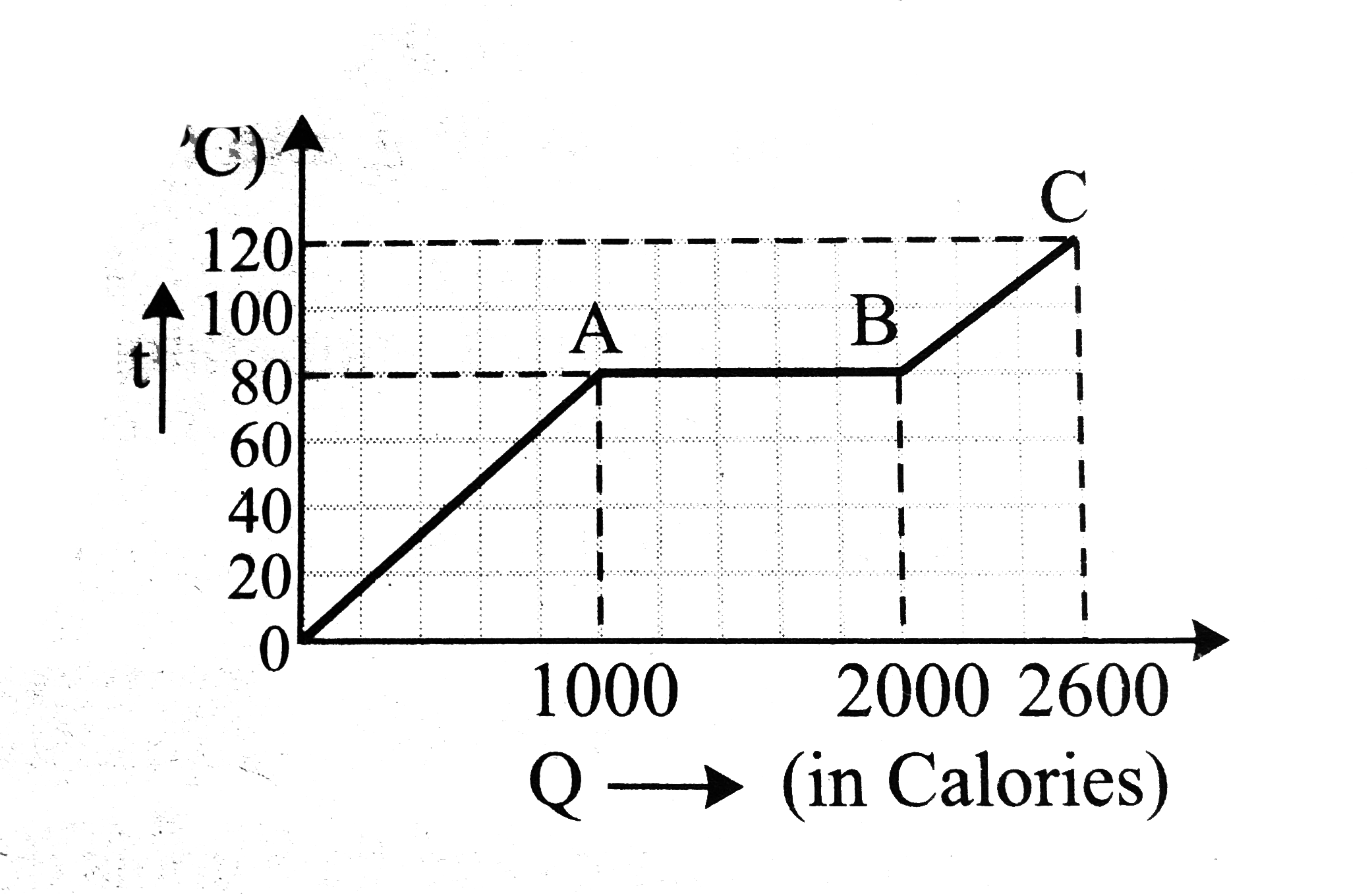A substance initially in solid state at 0∘C is heated. The graph showing the variation in temperature with the amount of heat supplied is shown in Fig. 11.7. If the specific heat capacity of the solid substance is 500 J kg−1^∘C−1, use graph to find : (i) the mass of the substance, and (ii) the specific latent heat of fusion of the substance in the liquid state.
To solve the problem step by step, we will analyze the graph and use the given data to find the mass of the substance and the specific latent heat of fusion.
Step 1: Analyze the Graph
From the graph, we identify the following key points:
- From point A to B, the temperature increases from 0°C to 80°C.
- From point B to C, the temperature remains constant while the substance changes from solid to liquid (phase change).
- From point C to D, the temperature of the liquid increases.
Step 2: Calculate the Heat Absorbed from A to B
We know that the heat absorbed (Q) during the temperature increase can be calculated using the formula:
Q=m⋅c⋅ΔT
Where:
- Q = heat absorbed (in joules)
- m = mass of the substance (in kg)
- c = specific heat capacity (in J/kg°C)
- ΔT = change in temperature (in °C)
Given:
- c=500J/kg°C
- ΔT=80°C−0°C=80°C
- From the graph, the heat absorbed from A to B is Q=800J.
Step 3: Substitute Values to Find Mass
Using the formula:
800=m⋅500⋅80
Now, rearranging to find m:
m=800500⋅80
Calculating:
m=80040000=0.02kg
Step 4: Convert Mass to Grams
To convert kg to grams:
m=0.02kg=20grams
Step 5: Calculate the Specific Latent Heat of Fusion from B to C
During the phase change from solid to liquid (B to C), the heat absorbed is also given by:
Q=m⋅L
Where:
- L = specific latent heat of fusion (in J/kg)
From the graph, the heat absorbed from B to C is:
- Q=1600J−800J=800J
Step 6: Substitute Values to Find Latent Heat
Using the formula:
800=0.02⋅L
Rearranging to find L:
L=8000.02
Calculating:
L=40000J/kg
Final Answers
(i) The mass of the substance is 20 grams (or 0.02 kg).
(ii) The specific latent heat of fusion of the substance is 40,000 J/kg.
From the graph, we identify the following key points:
- From point A to B, the temperature increases from 0°C to 80°C.
- From point B to C, the temperature remains constant while the substance changes from solid to liquid (phase change).
- From point C to D, the temperature of the liquid increases.
We know that the heat absorbed (Q) during the temperature increase can be calculated using the formula:
Q=m⋅c⋅ΔT
Where:
- Q = heat absorbed (in joules)
- m = mass of the substance (in kg)
- c = specific heat capacity (in J/kg°C)
- ΔT = change in temperature (in °C)
- c=500J/kg°C
- ΔT=80°C−0°C=80°C
- From the graph, the heat absorbed from A to B is Q=800J.
Using the formula:
800=m⋅500⋅80
m=800500⋅80
m=80040000=0.02kg
To convert kg to grams:
m=0.02kg=20grams
During the phase change from solid to liquid (B to C), the heat absorbed is also given by:
Q=m⋅L
Where:
- L = specific latent heat of fusion (in J/kg)
- Q=1600J−800J=800J
Using the formula:
800=0.02⋅L
L=8000.02
L=40000J/kg
(i) The mass of the substance is 20 grams (or 0.02 kg).
(ii) The specific latent heat of fusion of the substance is 40,000 J/kg.
Topper's Solved these Questions
- CALORIMETRYBook:ICSEChapter:CALORIMETRYExercise:EXERCISE-11(A)
Explore 30 Videos
- CALORIMETRYBook:ICSEChapter:CALORIMETRYExercise:EXERCISE-11(A) (MULTIPLE CHOICE TYPE)
Explore 3 Videos
- WORK ENERGY AND POWERBook:ICSEChapter: WORK ENERGY AND POWERExercise:EXERCISE-2(C ) NUMERICALS
Explore 6 Videos
- CURRENT ELECTRICITYBook:ICSEChapter:CURRENT ELECTRICITYExercise:EXERCISE-8(C) NUMERICALS
Explore 35 Videos
Similar Questions
The substance having the highest specific latent heat of fusion is
View Solution
A substance is in the solid form at 0∘C. The amount of heat added to this substance and its temperature are plotted in the following graph. If the relative specific heat capacity of the solid substance is 0.5, find from the graph (i) the mass of the substance, (ii) the specific latent heat of the melting process and (ii) the specific heat of the substance in the liquid state.
Specific heat capacity of water =1000cal/kg/K
View SolutionA substance is in the solid from at 0∘C. The amount of heat added to this substance and its temperature is plotted in the graph . The specific heat capacity of the solid substance is 0.5cal//g∘C.
_E01_233_Q01.png)
The mass of the substance is -
View SolutionState in brief, the meaning of each of the following:
The specific heat capacity of copper is 0.4 Jg1∘C−1
View SolutionA substance is in the solid from at 0∘C. The amount of heat added to this substance and its temperature is plotted in the graph . The specific heat capacity of the solid substance is 0.5cal/g∘C.
_E01_235_Q01.png)
Specific heat capacity in the liquid state is -
View SolutionA substance is in the solid from at 0∘C. The amount of heat added to this substance and its temperature is plotted in the graph . The specific heat capacity of the solid substance is 0.5cal/g∘C.
_E01_234_Q01.png)
Latest heat capacity in melting process is -
View SolutionState in brief, the meaning of each of the following:
The specific latent heat of fusion of ice is 336000 J kg−1
View SolutionSpecific heat capacity of substance A is 3.8Jg−1K−1 whereas the specific heat capacity of substance B is 0.4Jg−1K−1.
How is one led to the above conclusion ?
View SolutionThe specific heat capacity of a substance A is 3,800Jkg−1K−1 and that of a substance B is 400Jkg−1K−1. Which of the two substances is a good conductor of heat ? Give a reason for your answer.
View SolutionSpecific heat capacity of substance A is 3.8 J/gK, whereas the specific heat capacity of substance B is 0.4 J/gK
Which of the two is good conductor of heat ?
View Solution